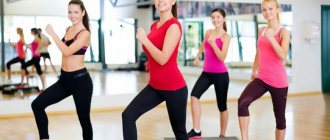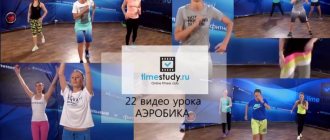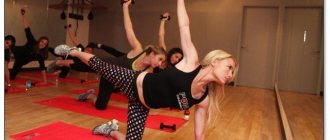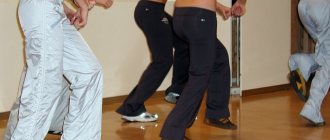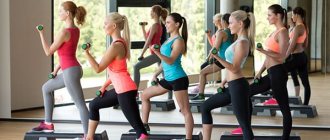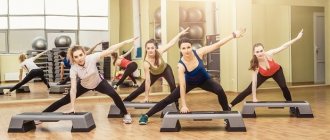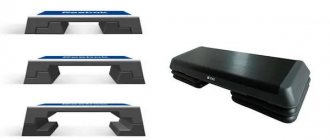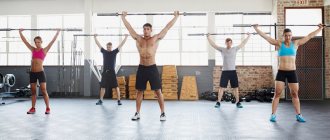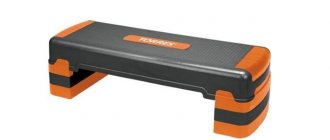Many people believe that fitness is something incredibly difficult and exhausting, bringing absolutely no pleasure. Actually this is not true. They can indeed be tiring, but you can always find an activity that you find enjoyable, easy and inspiring. For many people, the source of all this was step aerobics. What are these activities and what are their benefits ?
What is step aerobics?
Step aerobics is a high-intensity type of aerobics using a step platform. Performing a combination of basic steps on a platform, in the form of dance sequences, strengthens the cardiovascular system, improves muscle tone, speeds up metabolism, and burns subcutaneous fat.
Step aerobics appeared in the 1980s, when classical aerobics was at the peak of popularity, fitness trainers Gene Miller and Kelly Watson developed dance moves using a step platform, which are still used in all clubs today. Stepping up to the rhythm of music at a high speed, suitable for burning fat, will provide a workout for the entire body, improving overall fitness and well-being. Step aerobics classes will help you lose weight and strengthen your muscles even at home.
However, aerobic exercise may be too intense and puts a lot of stress on the heart, so consult your doctor before starting.
The intensity of the workout is determined by the speed of the music; the optimal tempo is 135 – 145 beats per minute. Sometimes, an advanced level of load can reach a rhythm of 150 beats. But this pace can be dangerous for beginners.
Exercise 15 - push-ups in front of the chest
- You need to stand in front of the step platform. Starting position - feet shoulder-width apart.
- Bend over and place your palms on the step. Try to keep your back straight.
- Jump up and move your legs back. Push up to form one line. Don't arch your back!
- Next, jump up and bring your feet back closer to the step platform.
- Release your arms and return to the starting position.
After performing the exercises, be sure to stretch for 5 to 10 minutes so that your muscles recover faster after training.
If you liked our article and have any thoughts on this matter, please share with us. It is very important for us to know your opinion!
The benefits of step aerobics
- The cardiovascular system. Step aerobics is a way to make your lungs and heart work at an increased speed. Exercise prevents heart and arterial diseases. The more blood enters the muscles, the more oxygen they receive. In general, the body's endurance increases and its recovery rate increases. When you exercise, your heart rate increases and your breathing becomes faster. This type of activity affects the cardiovascular system and makes it stronger over time. Regular cardio exercise can help prevent high blood pressure and heart disease.
- Musculoskeletal system. Muscle health is related to bone density and strength. Step aerobics can improve bone and joint health and prevent future problems. This type of fitness is aimed at increasing bone mass and density. This is due to the specific nature of the exercises - the loads of jumping and hitting, that is, the constant tension and pressure caused by the exercises stimulate the bones to create more bone cells, thereby increasing their density, size and strength. Essentially, this is the same process as muscle growth. Step aerobics helps fight the effects of degenerative bone diseases and prevents osteoporosis.
- Step aerobics for weight loss. One of the biggest benefits you can get from aerobics is weight loss. Since step is a cardio exercise, together with strength exercises, it burns more calories, respectively, from fat. 45 minutes of step aerobics burns up to 450 calories. If you want to burn as many calories as possible, then you need to increase your pace and also increase the height of your steps. Excess weight, or even obesity, can cause problems with bones and joints, heart, lungs, stroke or diabetes. Therefore, aerobics is a great way to stay fit and help reduce the risk of all health problems.
- Mental health. Exercise causes the brain to release chemicals known as endorphins. Endorphins are hormones that make you feel happy, causing a feeling of delight and satisfaction. Without enough endorphins, you can become depressed, tired, and constantly experience stress and anxiety. People suffering from depression, anxiety and other mental problems can safely take up step aerobics classes.
- High metabolic rate. Another benefit that can be associated with step aerobics is that your metabolism increases dramatically. This helps break down fats already stored in the body as fuel for energy. High intensity training can also increase the production of human growth hormone. As we get older, the body produces less growth hormone, thereby stimulating the aging process and also reducing the metabolic rate.
- Load versatility. Another advantage of step aerobics is that it is universal. People of all fitness levels can do this activity because the load and difficulty can be easily modified to suit everyone. Beginners can perform the movements more slowly, on a low platform, while advanced ones can increase the tempo, difficulty of the sequence and height of the platform.
Dance Characteristics
Tap is an American dance, but in a slightly modified form it was developed in Europe. The main feature of American tap dance, which is called jazz, is free movements, which makes the dance very graceful and smooth. The European style of tap is more similar to Irish or English dance, which is danced in wooden shoes (country tap). The movements of this style are more springy, but the body of the dancers remains motionless. Whatever style you choose, the main feature of this dance is that the performers always improvise, expressing their mood through dance.
Interesting facts about steppe
Foot dance has several names: “tap dance”, “step”, “jiga”. Experts say that the true ancestors of step dance are Irish jig and African dances with their characteristic syncopated rhythm, sliding and shuffling movements. Tap is a charismatic and free dance. Tap rhythms are very musical and very infectious! Hearing them, you want to jump up and tap out something yourself. And this turns out to be difficult. Tapdance is quite difficult. Even simple elements are not obtained immediately. It is not enough to make a movement technically correct. You also need to do it very quickly and so that the heels clearly beat the rhythm. It will take a lot of effort to master it, but the result will pleasantly surprise you!
Tap dancers are not only dancers, but also musicians, where the musical instrument is their feet. Tap dance is a way of self-expression. Like jazz musicians in improvisation, dancers tap out the rhythm that their mood, heartbeat and rhythms of life tell them.
Contraindications to step aerobics classes
There have been studies that show that step aerobics exercises are good for your joints and can make them stronger. But this only applies to healthy people. For people who already suffer from problems with the spine and joints, such as osteoporosis, hernias, protrusions, inflammatory processes, jumping loads can do more harm than good. High-intensity exercise with high blood pressure is also contraindicated, since aerobics can increase it; hypertensive patients should avoid high-level cardio exercises.
The history of step dance
“Step” is translated from English as a step, although for a dance with this name the word “tep” (from the English “knock”) would be more typical. Like tap dancing, this is a dance in post-Soviet countries.
Legends bring to us amazing stories where the birth of step is associated either with the ancient Egyptian priests, who, worshiping the god Ra, performed ritual dances on drums, hitting them with their feet, or with African musical and dance traditions, where the sound carried certain information.
The most popular version says that step has both European and African roots, which are intertwined on the American continent. Tap came to America through a mixture of many cultures that had similar dance movements, primarily coming from Irish and African traditions. The end of the 19th and beginning of the 20th centuries is considered the time when tap dancing appeared and its gradual spread throughout the world.
The characteristic knocking sound during dance performance, which appears due to percussive footwork, was first extracted using hard shoes on hard wooden surfaces, but over time, suitable objects began to be stuffed to enhance the sound: small coins, beer caps, metal staples. The real invention was the appearance of special metal heels.
There is a legend that in 1907, step was first demonstrated by American dancers of African-American origin in St. Petersburg. They were honored to speak at a reception in the Winter Palace. The features of American tap dance were picked up by Russian dancers, who had previously used Russian fractions and gypsy tap dancing.
At the beginning of the 20th century, two directions in the development of step dance appeared. One was associated with high speed and movement. The most popular dancers in this direction are Jimmy Doyle and Harland Dixon. The second movement was distinguished by an elegant and graceful manner, and its typical representative at that time was George Primerose.
Tap dance owed its particular popularity to Hollywood musicals in the 30s and 40s of the 20th century. Attention was also drawn to it because clear rhythms began to be associated with technical progress, the sound of railways and cars.
We can say that step grew and developed simultaneously with jazz, which expanded the melodic and rhythmic repertoire of this dance. The syncopated structure of jazz compositions was ideally combined with tap movements. Having become a frequent guest of musicals, variety shows and black-and-white cinema, step confidently conquered the world.
Famous actors and dancers have enriched step dance with elements from classical ballet and modern dance.
Even having lost particular popularity in the 50s of the last century, step dance was not forgotten. This is evidenced by the celebration of International Tap Dance Day on May 25th.
Modern tap has certainly changed, but still commands attention on the dance scene. Over time, a new direction for amateur dance also appeared in Europe and America - something similar to aerobics only in combination with step.
Types of steppe and their features
Tap is called the music of the feet, so it can be performed to various musical compositions and even without music at all.
The names of steps and kicks are traditionally called in English. All steps can be combined in one performance, or performed as separate directions (types) of step.
The most popular of them are:
- Acro-tap (acro-tap) Alternating tap dance combinations and acrobatic tricks.
- Ballet tap, classical tap (ballet tap, classical tap) Introduction of ballet movements into tap rhythms.
- Cane tap (tap dance with a cane) The cane is used in dance both to create a stage image and for tapping in combination with foot rhythms.
- Tap dance, tap (tap dance) Clear rhythmic patterns that are created by tapping with the foot, heel and toe.
Types of step aerobics classes
- Basic Step. Initial level of load, training in basic steps.
- Step advanced. Increasing the complexity of the basic level program, increasing the load and complexity.
- Step-comb. Combining basic movements into more complex combinations.
- Step-interval. Interval training, dance routines alternate with strength exercises.
- Double Step. Training using two step platforms.
- Dance Step. A dance type of step aerobics using elements of disco, house and others.
How to build a lesson
- Start your workout with a simple warm-up.
- Perform the exercises sequentially in 3 sets of 15 repetitions each.
- Skip exercises that are difficult for you. “If some movement is still very difficult for you, do not perform it, but return to it after 4-5 workouts - let the muscles adapt and get stronger,” says Stepan Proshin.
- Do this program 3 times a week .
- Finish your workout with light stretching .
To perform the exercises of the complex you will need a step platform and a mat.
Basic level of step aerobics
One-legged steps
Basic step – rise to the step one by one, starting with the right foot, then the left, returning to the floor also with the right foot.
V-step - feet on the floor together, steps from the right foot to the right edge of the platform, left to the left edge, return to the floor to the starting point - feet together (performing a V-shaped movement).
Over the top - standing sideways on the step, the right leg lowers to the floor on the right side, the left leg to the floor on the left side, and returns from the right to the step, then the left.
Straddle - step with the right foot to the left edge, turn your back, step with your left foot onto the step, and with a turn, return to the starting point from the right foot to the floor.
Steps with alternating legs
Knee up - step with the right foot to the left edge, lift the knee of the left leg up, switch to the other leg - lift the right knee.
Step kick - a step movement similar to Knee up, instead of raising the knee up, a kick (swing) is performed with the foot forward, and also on the other side.
Step curl - like the Knee up, instead of the knee, the heel is crossed to the buttocks, repeated on the other side.
Step lift - as with a Step kick, the leg swing is done to the side or back, also to the other side.
L-step – step with your right foot to the left edge of the platform, lift your left knee up, lower the same leg to the floor near the edge of the platform, and lift your right knee up. Place your right one on the step, and once again lifting your left knee, place your left foot in front of the platform and move to the other side. Do the same on the other edge of the platform.
You can learn step aerobics exercises (steps) using video lessons, analyze the movements by counting, and perform the sequence together with the instructor. For an advanced level of step aerobics, these movements are performed in a more complex combination, in the form of step choreography. The movements become more complex, the tempo of the music accelerates. If the aerobic part is completed in 30-45 minutes, the rest of the time (15-30 minutes) is devoted to strength exercises with dumbbells or body bars.
Exercise 6 - maximum load on the legs
The exercise is suitable for those who have high endurance, as it uses a platform with maximum height.
- First you need to stand sideways to the step platform.
- Jump on it with both feet and jump again around your axis.
- During the jump, it is recommended to make as many turns as possible to the starting position - first in one direction, then in the other.
- Beginners are allowed to make four turns, then three and two.
After you have mastered this exercise, do jumping jacks on the platform on one leg, then on the other.
Do the exercise without distractions, carefully!
Step platform and sports equipment
The most necessary attribute for training will be a step platform. There are several types of different sizes and heights, each platform is selected depending on the level of training, price, quality, brand, etc.
Clothes should not restrict the body; it is advisable to choose clothes made of elastin.
Sneakers should be comfortable; it is advisable to choose a running model.
Contraindications
Step aerobics is allowed for everyone except untrained people over fifty years of age and those for whom doctors have prohibited it. Everyone else can safely start classes. But you need to train correctly, otherwise the result will not be slimness and vigor, but fatigue and injury.
There is no question about whether you are for step aerobics or against it. Here are some facts from the world of step aerobics:
- Step aerobics is the most popular type of aerobic exercise in more than thirty countries around the world.
- Step aerobics has a beneficial effect on joints and posture. Regular exercise can prevent osteoporosis and arthritis, which usually occur due to lack of exercise.
- Step aerobics classes have a positive effect on the psyche no less than on the body. The percentage of depression and neuroses in those who train is sharply reduced.
- There are more than two hundred ways to get up and down from the platform.
- Increasing the height of the step by just five centimeters increases the load by 12%.
- According to statistics, for every thousand hours of step aerobics, there is only one injury.
- The effect of the classes becomes noticeable after just a month and a half of training!
There is nothing more pleasant than the feeling of muscles strained by training. Each one makes itself felt with languid fatigue, which will grow into strength and beauty. If you don’t dream of gaining an additional twenty kilograms of muscle, but simply want to gain excellent posture, a slender waist and legs, a toned body, and increase its plasticity and coordination, then it’s hard to think of anything better than step aerobics.

